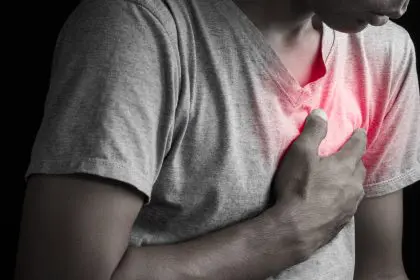What began thousands of years ago as a cultural bathing ritual has evolved into one of the most promising preventive health practices backed by modern research. Regular sauna use, the practice of sitting in heated rooms that typically range from 150°F to 195°F, appears to offer substantial cardiovascular benefits comparable to moderate-intensity exercise. Long embraced in Finland where nearly every home contains a sauna, this heat therapy tradition is gaining scientific recognition for its potential role in heart disease prevention, the leading cause of death globally.
Heat exposure as cardiovascular medicine
The research supporting sauna benefits has grown from isolated observations to substantial longitudinal studies. A landmark 20-year Finnish study tracking over 2,300 men found those using saunas 4-7 times weekly showed 63% lower risk of sudden cardiac death and 50% reduced cardiovascular mortality compared to those using saunas once weekly.
These striking numbers initially met with skepticism have since been reinforced by mechanistic studies identifying specific physiological changes that occur during and after sauna sessions. Rather than mere relaxation, sauna bathing prompts measurable adaptations in cardiovascular function similar to those induced by aerobic exercise.
The intensity of these effects appears dose-dependent. Frequency matters more than duration, with consistent weekly sessions providing more benefit than occasional longer exposures. The sweet spot appears to be 3-4 sessions weekly lasting 15-30 minutes each, at temperatures between 175°F and 195°F, though benefits begin at lower frequencies.
7 ways saunas strengthen your heart
Regular sauna use promotes heart health through multiple mechanisms working in concert:
Blood pressure reduction: Sauna heat causes peripheral blood vessels to dilate, temporarily lowering blood pressure during the session and for up to 30 minutes afterward. Over time, regular exposure appears to improve blood vessel elasticity, contributing to sustained blood pressure improvements. A Finnish study found regular sauna users had 47% lower hypertension risk compared to infrequent users.
Heart rate variability improvement: This critical measure of cardiovascular health reflects how well the heart adapts to changing demands. Research shows sauna sessions increase heart rate variability, indicating better autonomic nervous system balance and enhanced stress resilience.
Endothelial function enhancement: The endothelium—the inner lining of blood vessels—regulates blood flow, influences clotting, and affects inflammation. Regular heat exposure improves endothelial function by increasing nitric oxide production, enhancing blood vessel dilation and reducing arterial stiffness.
Favorable lipid profile changes: Several studies indicate regular sauna use may positively affect cholesterol levels, including modest reductions in LDL (low-density lipoprotein) and increases in HDL (high-density lipoprotein). While these changes are less dramatic than those achieved through medication, they represent another heart-protective mechanism.
Inflammation reduction: Chronic low-grade inflammation contributes significantly to heart disease progression. Sauna exposure reduces several inflammatory markers, including C-reactive protein and interleukin-6, potentially slowing atherosclerosis development and reducing cardiac event risk.
Stress hormone modulation: Regular heat exposure appears to optimize cortisol patterns and reduce chronic stress, a significant heart disease contributor. The parasympathetic nervous system activation following sauna sessions promotes recovery and reduces cardiac strain.
Improved cardiorespiratory fitness: Regular sauna users typically demonstrate higher VO2 max (maximum oxygen uptake during exercise), a key predictor of cardiovascular health and longevity. This improvement likely results from the heart adaptations required to manage the increased cardiac output during heat exposure.
Finding your ideal sauna routine
While research supports sauna benefits, individualized approaches remain important. Different sauna types offer varying experiences and potential benefits:
Traditional Finnish saunas feature dry heat with temperatures between 175°F and 195°F and humidity levels below 20%. These have the strongest research backing for cardiovascular benefits but represent the most intense heat exposure.
Infrared saunas operate at lower temperatures (120°F-140°F) while heating the body directly rather than heating the air. While research specifically on infrared saunas is less extensive, preliminary studies suggest similar benefits with potentially better tolerance for heat-sensitive individuals.
Steam rooms provide high humidity (100%) at lower temperatures (110°F-120°F). While less studied specifically for cardiovascular outcomes, they offer another heat exposure option that some find more comfortable for respiratory systems.
Beginning gradually allows the body to adapt to heat stress. First-time users should start with 5-10 minute sessions at lower temperatures, gradually increasing as tolerance develops. The optimal routine appears to be 15-20 minutes per session, repeated 3-4 times weekly, though benefits begin with just 2 weekly sessions.
Heart patients and special considerations
Despite promising research, sauna use requires careful consideration for those with existing heart conditions. The cardiovascular adjustments during sauna bathing, including increased heart rate, altered blood pressure, and blood vessel dilation, create physiological demands.
Individuals with unstable angina, recent heart attacks, severe aortic stenosis, or uncontrolled high blood pressure should generally avoid saunas until their condition stabilizes. Those with stable heart disease might potentially benefit but should consult healthcare providers first and start with very brief, low-temperature sessions.
Proper hydration remains essential for everyone using saunas. The typical session produces 0.5-1 liter of sweat, requiring fluid replacement before, during, and after sauna use. Electrolyte balance becomes particularly important with frequent or prolonged sessions.
Alcohol consumption before or during sauna use significantly increases risks by impairing temperature regulation and promoting dehydration. The combination has been associated with dangerous drops in blood pressure and arrhythmias in susceptible individuals.
Comprehensive health impact
While cardiovascular benefits drive much sauna research, heat exposure appears to offer broader health improvements. Regular sauna users report better sleep quality, reduced chronic pain, lower stress levels, and improved mood, factors that indirectly support heart health.
Immunological benefits have gained attention, with research suggesting regular sauna users experience fewer respiratory infections. Heat exposure increases white blood cell counts, enhances natural killer cell activity, and induces a mild fever-like state that may improve immune surveillance.
The neurological impact deserves particular mention. Several studies link regular sauna use with reduced dementia and Alzheimer’s risk, potentially through improved cerebral blood flow, reduced inflammation, and increased brain-derived neurotrophic factor production, a protein supporting neuron health.
Cultural context and accessibility challenges
Finland’s sauna tradition incorporates social connection alongside physiological benefits. Communal sauna experiences foster relationships and stress reduction, potentially amplifying health benefits. This cultural element may partially explain why Finnish research shows particularly strong outcomes.
Accessibility remains a significant barrier in many regions. While gym and spa facilities increasingly offer sauna options, regular access often requires membership fees. Home sauna installations, while becoming more affordable with infrared options, still represent significant investments.
The research momentum continues building as investigators explore optimal protocols, mechanisms of action, and applications for specific health conditions. Heat therapy, once dismissed as merely relaxing, increasingly appears to be potent preventive medicine for the cardiovascular system.















